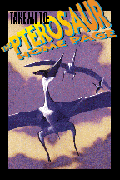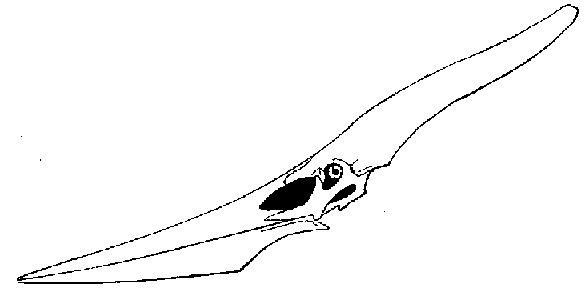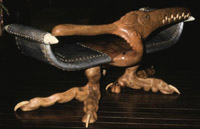
Pteranodon Marsh 1876 "winged no-tooth" ("toothless flyer")
te-RAN-o-don (Gr. pteron "wing" + an- "no, without" + Gr. odon "tooth")* (m) Marsh says: "distinguished from all previously known genera of the order by the entire absence of teeth." Pterodactyloidea Pteranodontidae L. Cret. NA.
Pterodactyls have fascinated me since I was 4 years old. In fact, for a long time I thought they still existed. I remember being startled in the forest near a creek by a Great Blue Heron, and trying desperately to convince my parents, and everyone around, that I had SEEN a pterodactyl. To this day, I am still startled by the resemblance that a distant heron has to a pterodactyl.
Yes, I collect pterodactyls, though oddly, not on stamps. Oh, I have a couple of stamps, which I will place on this page soon, but I prefer 'dactyls that can I hold. I have several stuffed ones, some glow-in-the-dark skeletons, and a lovely pewter one standing guard over a crystal egg as if his whole life depended on its safety! With that feverish intensity of concern he shows, I like to think he's watching over ME... I also have a very special Native American flute that a friend carved for me that has SEVEN pterodactyl images scattered among the sapwood of the flute as well as a carved one in flight. Click here to see the Pterodactyl Flute
The reptilian "bird" that I love so much is officially known as Pteranodon longiceps. That's the one with the long crested skull, though a pterosaur poster I have lists it as Pteranodon ingens. The skull length of P. longiceps is up to 5.9 feet (1.8m), its wingspan = 23 feet, (7m), with estimates to 30 feet. I think that is sufficiently large enough to protect that crystal egg, don't you? After all, without any teeth, he HAD to be big!
A more detailed scientific description of P. longiceps follows the poem.
I'd like to share a very strange poem that I wrote at around 2am one morning (most of my poetry comes to me in that hazy time between sleep and wakefulness). I simply woke up and started dictating into my recorder beside my bed. If you keep in mind that I am an only child who lived in a very rural area with no kids to play with who were my age (except one that my mom didn't like), then this won't seem so strange.
Pterydactyl and Tygerr
By many names my pal was known,
Until finally I chose
The name he'd have for ever more,
One sweeter than a rose.
And when I learned my dinosaurs,
A bird made my heart stand still!
He vied for the Archaeopteryx
But he became the Pterydactyl.
My companion finally had a form;
I could look him in the eye;
I'd hop upon his leath'ry back
And together we would fly.
We viewed the world from all around;
Through his eyes and through mine.
We talked of life and love and pain;
We were together all the time.
His unique shape and shadow still
Send shivers down my spine.
I knew my bird was special
As to the clouds we'd climb.
And then his form began to change -
I don't recall just when -
My Pterydactyl came to earth,
Screeched, transformed, and then...
...He became the Tygerr burning bright
A giant of a cat.
I could throw my arms around his neck
And hug him, just like that.
We prowled the forests and the beaches;
He followed me to school.
I'd meet him after class and then
We'd walk 'til it got cool.
But I grew up and had to leave
My bird and cat behind.
Now they're childhood mem'ries
Locked within my mind.
But I've retained a special thing,
A symbol of that friend;
I stitched myself a pillow -
One I'll never lend.
It's large and soft and huggable,
And alone I never feel;
As I curl up beside my pal
And imagine how warm I feel.
I tucked my playmate's moniker
Inside that sack of foam.
Three pillowcases with that name
From a place that I called home.
Stuffed inside and sealed up
So no one would ever know
That the Pterydactyl and the Tygerr
I never did outgrow.
Copyright 1-23-92 by Crystal Eikanger.
All Rights Reserved.
The following information is from the Pterosaur Home Page

Pteranodon longiceps
Pteranodon is known from thousands of specimens, mostly disarticulated and crushed bits and pieces. At least one nearly complete skeleton is known. Discovered in 1871 and originally named "Pterodactylus," the first specimens of this giant pterosaur created a sensation. They were the first pterosaurs to be discovered in North America and they were many times larger than the European forms. In 1876 the name Pteranodon was coined to distinguish the new pterosaur. Two forms are now recognized, the tall-crested P. sternbergi and the long-crested P. longiceps. In both species the snout is long, sword-like and toothless. The snout crest common to most pterodactyloids is present here, but blends almost indiscernably with the upper jaws. The lower jaws are provided with a flat palate just below the jaw line, so the volume the jaws can hold is not much. The neck bones have tall crests. The torso is short and provided with a notatrium (fused dorsal vertebrae) to anchor the scapulae. In like fashion the sacral vertebrae are fused to form a synsacrum. The tail is unusual in that the centra (spool-like body) of each vertebra are doubled side-by-side, and the tail is tipped by two long parallel needle-like processes. The sternum is broad and rectangular. The gastralia are thin and the prepubic bones form an 'H' shape. Enough pelvis specimens are known to divide them into genders. Those with wider rear openings are thought to have been female. The humerus (upper wing bone) has a warped deltopectoral crest. This warp gives the large wing muscles a straight path to the sternum, passing over the large chest. The metacarpals (hand bones) are very long and the wing claws are large. Presumeably Pteranodon was still able to climb trees despite its size. It was also able to walk bipedally although its wings would have provided excellent crutches to rest upon.
Reference:
Bennett, C. 1991. Morphology of the Late Cretaceous pterosaur Pteranodon
and systematics of the pterodactyloidea (volumes I and II). Ph.D. dissertation.
And then there is the BIZARRE:

This chair was carved out of a stump and has a pricetag of 20,000. No, I don't own it, but at that price, I WOULD prefer that it could also fly with those leather "wings"...
Here are some related links I think you'll enjoy!


You are visitor number:
Updated: November 16, 1998